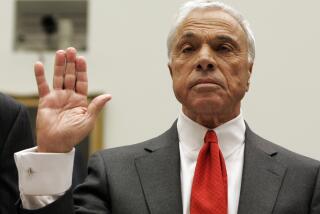Downey Team Tries to Rouse S&L; Sleeper : Thrift: New managers restructure the staff and plan to increase market share, asset size and profits, sending Wall Street a wake-up call.
- Share via
NEWPORT BEACH — Some stock analysts have long considered Downey Savings &Loan; a sleeper company--a profitable, well-run S&L; that hasn’t attracted much attention on Wall Street.
Others thought the thrift was simply asleep.
Now, Downey’s new managers, Robert L. Kemper and F. Anthony Kurtz, are trying to rouse any slumbering parts of the Newport Beach thrift and give Wall Street a wake-up call.
But before they get started, they have to get everyone at the institution used to a new way of doing things. That can be tough at a successful, long-established S&L; operated by its two co-founders for 35 years.
Kemper and Kurtz acknowledge that they can’t please everyone on the 935-employee staff.
“There’s a difference between owners running a business and professionals running a business,” said Kemper, Downey’s chief executive. “You need a different set of internal controls. It has nothing to do with good or bad practices before.”
Employees trying to adjust to a new management structure with formal lines of authority sometimes step out of line. They are quickly straightened out, Kemper said.
The new team also faced some tense moments with co-founders Maurice L. McAlister and Gerald H. McQuarrie, who have searched for several years for successors.
“The process was not unlike putting your children up for adoption,” said Kurtz, Downey’s new president.
In their first interview since taking over at Downey, Kemper and Kurtz talked about some of the changes they’ve made and their plans for the future.
Under the “two Macs,” as they came to be known, Downey built a reputation for conservative home lending and a highly profitable business of developing neighborhood shopping centers and residential tracts. It escaped most of the troubles that brought down so many other S&Ls;: incompetence, economic woes and outright fraud.
Yet it hasn’t been setting Wall Street on fire, partly because its conservatism has also limited its growth. That’s something the two Ks, Kemper and Kurtz, hope to change.
The outside world won’t notice much of a change, they said. The thrift will continue to offer its traditional products, such as checking and savings accounts and home loans.
But they have restructured the staff, replacing certain executives with their own people. And they plan to be much more aggressive in originating loans and acquiring other thrifts or their branches.
The effort is aimed at increasing Downey’s market share, asset size and profits, and shoring up its lackluster stock performance. The thrift’s stock has been trading below its $17-a-share book value--the net value of its assets if they were liquidated and debts were paid. The thrift has $3.8 billion in assets.
The stock closed Monday at $13.375, down 62.5 cents a share in New York Stock Exchange trading. It has rebounded from its 1991 low of $10.625, but remains well behind its all-time high in the late 1980s of $24.125.
“There’s still not a terrible amount of interest in Downey stock,” said James F. Wilson, an analyst with Montgomery Securities in San Francisco.
Downey’s earnings fell to $24.9 million last year from $42 million in 1990. Its assets and loans were also down from the previous year. Downey is under a federal mandate to rid itself of most of its real estate holdings, a difficult task in a recessionary market.
But perhaps its toughest sell is Wall Street. Wilson is one of a few analysts--mostly on the West Coast--to cover Downey. New York ignores the thrift.
“You don’t get much clout until New York recognizes you,” Wilson said. “And it’s tough to get positive momentum.”
Other analysts are more optimistic. Donald Crowley of Keefe, Bruyette & Woods in San Francisco is recommending the stock to investors.
“Our view is quite positive,” Crowley said. “It’s got very high-quality assets, and its problem assets are even lower than Golden West’s,” the parent of highly touted World Savings & Loan in San Francisco.
One thing all the analysts agree on is that the hiring of Kemper and Kurtz was a good move by the directors and the two co-founders, McAlister and McQuarrie, who founded the thrift in 1956.
“Kemper is very sophisticated, and we’re favorably impressed with Kurtz as well,” Crowley said.
Kemper, 62, is a former vice chairman of Wells Fargo Bank, where he worked for 27 years. In recent years, he was director of the National Center on Financial Services at UC Berkeley and managing director of a New York merchant bank.
He was hired in July, 1990, as chairman of Great American Bank to try to rescue the failing San Diego thrift. It was there that he met and hired Kurtz as his executive vice president and chief financial officer.
Kurtz, 50, who was chief financial officer of the company that owns the Price Club chain, had held the same position at H.F. Ahmanson & Co., the parent of Home Savings of America. Kurtz had been with Ahmanson for 20 years.
Kemper and Kurtz inherited day-to-day control of what industry analysts have long recognized as one of the nation’s best-run, more profitable S&Ls.; But they also inherited a thrift that was run under a loose corporate structure.
Until last year, for instance, Downey never had a chairman or a chief financial officer. McAlister, as president, ran the daily thrift operation much like a chief executive would, while McQuarrie, the chief executive, acted more like a president in dealings with trade groups, regulators and the public.
McAlister now is Downey’s chairman and president of its real estate subsidiary, while McQuarrie is vice chairman.
The hiring of Kemper and Kurtz in September soothed regulators, who had tangled with the co-founders over the thrift’s financial condition. The regulators also put pressure on McAlister, 66, and McQuarrie, 71, to find successors and to realign the thrift’s management structure.
“They made several attempts in recent years to make the (leadership) transition, but it just didn’t work out,” Kurtz said. Now, Kemper solves the succession problem, and Kurtz is lined up to take over from Kemper.
The new leaders minimized Downey’s battles with regulators over the last three years. Kemper said the disagreements over accounting procedures were overblown and never presented a serious threat to the institution.
Those fights led to last summer’s major write-downs on assets, especially the securities portfolio, and resulted in a $9.6-million third-quarter loss. But the institution posted a solid profit for the year and increased its already strong capital base.
In fact, Kemper and Kurtz have a lot to work with at Downey, industry analysts said.
The S&L; has long been recognized for the quality of its loans and real estate investments. Its rate of bad loans to total loans increased during last year’s recession but is still less than 1%, well below the industry average.
It also was the biggest builder in California and Arizona of neighborhood shopping centers--until the 1989 federal law restructuring the industry required all thrifts to get rid of such investments.
Downey’s hidden strength comes from its ability to attract core deposits, which are low-cost accounts held by local residents unlikely to transfer their accounts elsewhere. Analysts said 90% of Downey’s funding comes from core deposits at its 51 branches. The industry typically gets less than 70% of its money from core deposits, analysts said.
Kemper acknowledges that there is a price to be paid for formalizing the business. But it is not just the thrift and the regulators who will be better served. It will be the customers.
“In the end, we have to do what’s right for our customers,” he said.
Wake-Up Call Rings at Downey Savings Earnings at slow-growing Downey Savings & Loan have fluctuated over the years, a function partly of the home loans its makes. New, more aggressive managment wants to push asset growth, attract investors and boost Downey stock prices. Stock Prices Revenue In millions of dollars ‘86: $306.60 ‘87: $266.19 ‘88: $329.68 ‘89: $383.07 ‘90: $399.23 ‘91: $340.16 Net Income In millions of dollars ‘86: $57.15 ‘87: $33.19 ‘88: $28.96 ‘89: $13.64 ‘90: $41.98 ‘91: $24.88 Source: Downey Savings & Loan
Key Figures at Downey S&L; Robert L. Kemper Age: 62 Title: Chief executive, Downey Savings & Loan
Education: Bachelor of science degree in accounting, University of Santa Clara, 1950; completed management programs, Rutgers University and Harvard Business School. Job background: 1956-83, held various posts with Wells Fargo Bank, including controller, chief financial officer and vice chairman; director, National Center on Financial Services, UC Berkeley; managing director, Gregory & Honemeyer, New York, 1989-90; chairman, chief executive and president, Great American Bank, San Diego, 1990-91. F. Anthony Kurtz Age: 50 Title: President, Downey Savings & Loan Education: Bachelor of science degree in accounting, Cal State Northridge, 1963. Job background: Controller, Transcoast Investment Co., Sherman Oaks, 1966-68; held various posts including senior vice president, chief financial officer and chief administrative officer, H.F. Ahmanson & Co., Los Angeles, parent of Home Savings of America, 1968-89; chief financial officer, Price Co., San Diego 1989-90; executive vice president, chief administrative officer and chief financial officer, Great American Bank, San Diego, 1990-91.
More to Read
Inside the business of entertainment
The Wide Shot brings you news, analysis and insights on everything from streaming wars to production — and what it all means for the future.
You may occasionally receive promotional content from the Los Angeles Times.










